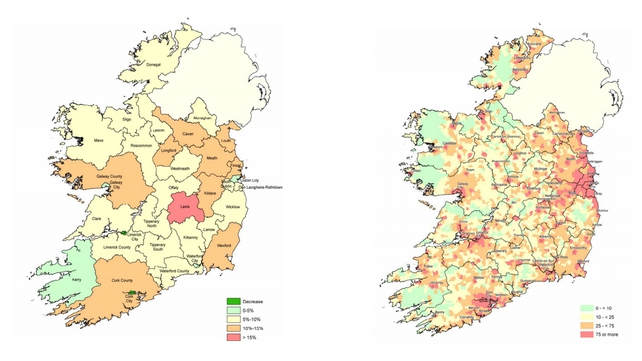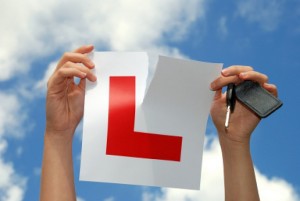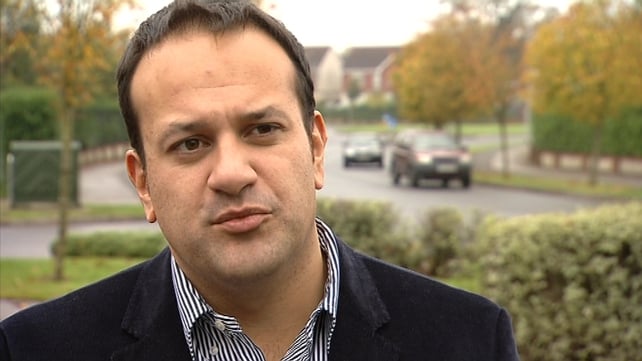ESRI study reveals over 20% live in jobless households


A new report from the Economic and Social Research Institute has found that 22% of the Irish population is living in jobless households, which is double the average across Europe.
The study says household joblessness should be recognised as a risk factor for poverty, and found that welfare payments were the most effective way of reducing poverty.
The ESRI focused on working age adults and their dependent children and the effects of the recession on them.
The report found that the percentage of people in jobless households increased from 15% in 2007 to 22% in 2010.
It says the high rate was partly due to the level of unemployment, but jobless adults in Ireland were more likely to live with children.
And the risk of living in a jobless household was higher for people with low levels of education, in lone-parent households and in households where an adult had a disability.
The report highlighted what it described as the “vital” role played by welfare payments in lifting these households out of financial poverty.
The research also looked at in-work poverty, where people have a job but are living in poor households.
This figure stood at 8% in 2010, similar to the European Union average.
The risk was higher for the self-employed, the report said, as well as for those in a low-skilled occupation, part-time workers and those with no educational qualifications.
Speaking on RTÉ’s Morning Ireland, Associate Research Professor with the ESRI Dorothy Watson said there are some unique factors which makes Ireland different than other European countries.
“We’re not just talking about unemployment when we’re talking about joblessness in households because there are other statuses…apart from unemployment that people who are not currently in employment might have.
“For instance they may be caring, they may be looking after young children, they may consider themselves unable to work because of disability and so on”, she said.
Prof Watson added that “the distribution of work across households isn’t random.
“There’s a tendency in Ireland for employment to be concentrated to some extent in some households and unemployment to be concentrated in others.”
Health service to hire 1,000 nurses


The health service is to recruit up to 1,000 graduate nurses and midwives next year at lower pay rates.
The move is aimed at reducing the reliance of hospitals and other health agencies on more expensive staff provided by agencies and is expected to save up to €10 million.
The HSE said that the graduate nurses and midwives would receive a two-year contract and be paid 80 per cent of the first point of the salary scale for a staff nurse.
The general secretary of the Irish Nurses and Midwives Organisation (INMO) Liam Doran said the union was “shocked” at the idea of paying the staff concerned 80 per cent of the rate and would be seeking talks with management on the issue.
The HSE said that it had received approval from the Government to recruit up to 1,000 graduate nurses and midwives to the public health service next year.
It said under the new initiative the graduate nurses would be deployed across the many specialities within HSE and HSE-funded services, which currently relied on agency staff and overtime in order to maintain services.
“The graduate nurses will receive a two-year contract and will be paid at a rate of 80 per cent of the first point of the salary scale for a staff nurse. “
“Those recruited can earn approximately €26,000 per annum including basic pay and premium pay.”
The HSE said the new initiative would allow it to reduce its reliance on agency nurses and overtime which it described as “unsustainable”.
The HSE said the new graduate nursing programme was expected to realise cost savings for the HSE in the region of €10million in 2013.
“It also provides 2012 nursing and midwifery graduates with an opportunity to gain substantial clinical experience to further their career and professional development, with the security of a 2 year contract and salary.”
Mr Doran said: “The INMO welcomes the recruitment of 1,000 new graduates on a two year contract. However the organisation is shocked at the idea of 80% of salary and will be having further discussions on this. The INMO also wants clarification on the educational dimension of the scheme.”
Population gap between Protestants and Catholics is closing Northern Ireland
Says the latest census.


It was published against the backdrop of continuing violence, which last night saw a policewoman attacked with a petrol bomb. Scenes of violence on the streets of Belfast that many had hoped were in the past.
Young Loyalists clashed with police again in parts of the east and south of the city.
They’re angry over a Belfast City Council vote to limit the number of days the union flag will be flown over Belfast city hall.
The violence took a more serious turn when a gang of around 15 protesters targeted an unmarked police car, smashed the windows and threw a petrol bomb inside the vehicle.
The female police officer inside was unharmed but police are treating the incident as attempted murder.
New Census figures show the demographic makeup of Northern Ireland, which has divided the region for so long is changing.
Last year, 48% of people identified themselves as Protestant, that’s down 5%.
While the number of Catholics rose by one per cent to 45%.
And seven per cent were neither Catholic nor Protestant.
For the first time, people were asked about their national identity.
40% say they consider themselves British Only.
While only 25% say they see themselves as Irish only and 21% Northern Irish Only.
The Loyalist protests are now in their second week and tensions are high on the streets of Belfast this evening.
Although most of the protests over the union flag decision have passed off peacefully, people here know that it only takes a few violent individuals to cause immense harm.
Learner drivers face penalty points


Learner motorists caught driving unaccompanied will shortly face a sanction of two penalty points with a further two for failing to display L-plates.
A new range of penalty points for motoring offences has been approved by Cabinet in the latest iteration of the Road Traffic Bill.
The Bill specifically outlaws the sending of text messages by motorists while driving, making it an offence to use or handle the keypad of a mobile phone for the purpose of sending or receiving information.
Penalty points for mobile phone use, including the new provision related to texting, will rise from 2 to 3 points (5 on conviction) under the 2012 Bill, Minister for Transport Leo Varadkar confirmed this afternoon.
Learner motorists caught driving unaccompanied will shortly face a sanction of two penalty points with a further two for failing to display L-plates.
For each offence the penalty is increased to four if the driver is convicted in court. At the end of 2011 there were more than 271,000 learner permit holders in the State, equivalent to one in 10 drivers.
The new Bill also halves from 12 to six the number of penalty points a learner motorist can accumulate within a three-year period before losing their licence. It is expected this provision will apply only to learner permits issued or renewed after the legislation is enacted as new sanctions cannot be retrospective.
For all motorists the penalties for speeding, failing to wear a seatbelt or using a mobile phone will increase from two to three points and, upon conviction in court, to five.
Mr Varadkar said that the new Bill would also address the anomaly that the legality of texting was unclear. This would become a specific offence he said. Current legislation makes it an offence to hold a mobile phone while driving and the new Bill clarifies that this also relates to texting.
“Ireland has made huge strides in reducing road deaths, under successive governments. However, we can never become complacent about road safety”, Mr Varadkar said.
“My Department is also bringing forward a range of other long-term measures in the Road Traffic Bill 2012. Ireland is currently ranked sixth in the EU for road safety. I want us to become the safest country in Europe,” he added.
The repair and resale of a written-off vehicle will be prohibited by a new provision which will see a vehicle deemed unroadworthy by the NCT being removed from the national vehicle file and barred from passing an NCT test.
The Bill also contains a provision for roadside impairment tests to detect drug driving. This was originally provided for in the 2010 Road Traffic Act and gardaí have been trained in those techniques.
Concerns over the robustness of the power of arrest provisions of the Act meant it was never enacted and has been rewritten.
Under the new legislation medical professionals will be allowed to take a blood sample from an unconscious driver which will not be tested until they can give consent.
To encourage the uptake of electric vehicles the Bill contains enabling legislation to allow local authorities provide parking and charging bays in public places, as well as parking bays for car club vehicles.
Since 2008, all learner drivers, including those on a second provisional licence, are required to be accompanied by a fully qualified driver.
Currently, those found in breach face a fine of up to €1,000. However, a recent Garda operation targeting unaccompanied driving found almost half flouted this requirement.
Gardaí stopped 2,200 learner drivers in March and found 43 per cent were unaccompanied. Some 30 per cent were not displaying L-plates.
Last year 3,150 learner drivers were summonsed for driving unaccompanied and of these 854 were convicted, with an average fine of €150. The maximum fine of €1,000 was not imposed.
There have been 154 deaths on Irish roads this year, 20 fewer than the same period last year.
Loneliness increases risk of dementia


Feeling lonely can increase the risk of Alzheimer’s in later life, a study suggests.
Researchers who found the link drew a distinction between being alone and loneliness.
The Amsterdam Study of the Elderly (Amstel) looked at risk factors for depression, dementia and high death rates among 2,000 men and women aged 65 and older.
Participants who felt lonely were more than twice as likely to develop Alzheimer’s and other forms of dementia as those who did not.
When influential factors including mental and physical health were taken into account, loneliness was still associated with a 64pc increased risk of the disease.
But other aspects of social isolation, such as living alone and being widowed, had no impact.
At the start of the Dutch study, 46pc of participants were living alone and half were single or no longer married. About one-fifth said they felt lonely.
 The findings were reported in the ‘Journal of Neurology, Neurosurgery & Psychiatry’.
The findings were reported in the ‘Journal of Neurology, Neurosurgery & Psychiatry’.
Feelings
The authors, led by Dr Tjalling Jan Holwerda from VU University Medical Centre in Amsterdam, wrote: “These results suggest that feelings of loneliness independently contribute to the risk of dementia in later life.
“Interestingly, the fact that ‘feeling lonely’ rather than ‘being alone’ was associated with dementia onset suggests that it is not the objective situation, but, rather, the perceived absence of social attachments that increases the risk.”
The researchers speculated that loneliness may be an effect of early dementia rather than its cause.
“We hypothesise that feelings of loneliness may . . . be considered a manifestation of the deteriorating social skills that are seen as part of the personality change accompanying the process of dementia.”
Another possibility was that loneliness signified extra sensitivity to distress, which is a known risk factor.
British expert Professor John Bond, from the University of Newcastle, said: “This is not the first paper to be published on this subject. However, this is a soundly conducted study and an important confirmation of the association.”
Jessica Smith, research officer at the Alzheimer’s Society, said: “More research is needed to determine whether it is a risk factor or, in fact, an early symptom. There is strong evidence to suggest that the best way to reduce your risk of dementia is by regularly exercising, eating a diet rich in fruit and vegetables and not smoking.”
Secret space-plane blasts off for mystery mission


The military’s small, top-secret version of the space shuttle rocketed into orbit Tuesday for a repeat mystery mission, two years after making the first flight of its kind.
The Air Force launched the unmanned spacecraft Tuesday hidden on top of an Atlas V rocket. As if on cue, clouds quickly swallowed up the rocket as it disappeared out over the ocean.
It is the second flight for this original X-37B spaceplane. The craft circled the planet for seven months in 2010. A second X-37B spacecraft spent more than a year in orbit.
These high-tech mystery machines — 29 feet long — are about one-quarter the size of NASA’s old space shuttles and can land automatically on a runway. The two previous touchdowns occurred in Southern California; this one might end on NASA’s three-mile-long runway once reserved for the space agency’s shuttles.
The military isn’t saying much if anything about this new secret mission known as OTV-3, or Orbital Test Vehicle, flight No. 3. In fact, launch commentary ended 17 minutes into the flight and a news blackout followed.
But one scientific observer, Jonathan McDowell of the Harvard-Smithsonian Center for Astrophysics, speculates the spaceplane is carrying sensors designed for spying and likely is serving as a testbed for future satellites. He dismisses rumors of “exotic ideas” for the X-37B as weaponry or shadowing a Chinese satellite.
While acknowledging he does not know what the spaceplane is carrying, McDowell said on-board sensors could be capable of imaging or intercepting transmissions of electronic emissions from terrorist training sites in Afghanistan or other hot spots. “All the sorts of things that spy satellites generally do,” he said.
The beauty of a reusable spaceplane is that it can be launched on short notice based on need, McDowell said.
What’s important about this flight is that it is the first reflight.
“That is pretty cool,” McDowell said, “reusing your spacecraft after a runway landing. That’s something that has only really been done with the shuttle.”
Now retired museum pieces, NASA’s space shuttles stretch 122 feet long, and have 78-foot wingspans and weights of more than 170,000 pounds. They were launched, from 1981 to 2011, with two strap-on booster rockets and an external fuel tank feeding three main engines. The X-37B wingspan is 15 feet, and the 11,000-pound, Boeing-built vessel requires the United Launch Alliance’s hefty Atlas V for hoisting. It is solar powered.
The two previous secret X-37B flights were in 200-plus-mile-high orbits, circling at roughly 40-degree angles to the equator, as calculated by amateur satellite trackers. That means the craft flew over the swatch between 40 degrees or so north latitude and 40 degrees or so south latitude.
That puts Russia’s far north out of the spaceplane’s observing realm, McDowell noted.
“It might be studying Middle Eastern latitudes or it might just be being used for sensor tests over the United States,” he said.
McDowell speculates that this newest flight will follow suit.
The International Space Station, by comparison, orbits about 250 miles (400 kilometers)high but at a much steeper 51.6-degree inclination, or angle to the equator, that covers more territory.
The X-37B program, which dates back to 1999, is operated by the Air Force Rapid Capabilities Office and geared toward space experimentation.
Some scientists – like Laura Grego of the Union of Concerned Scientists – argue the Air Force could accomplish the same objectives by using cheaper, more efficient spacecraft that either burn up on entry or parachute down.
“The ability to return to Earth carries a high price,” Grego said in a statement.
No comments:
Post a Comment